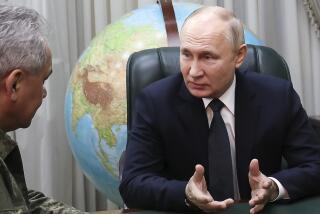Cheney Tours Soviet Air Defense Center : Military: The Pentagon chief gets his first look at the long-secret network, calls it ‘impressive.’
MOSCOW — The Soviet military on Thursday pried open slightly the lid on its long-secret air defense network, inviting Defense Secretary Dick Cheney into the underground command bunker of Moscow’s air defense district.
Cheney’s unprecedented visit to the nuclear-hardened command center began a day of Soviet military show-and-tell that ended with Soviet commandos diving into a pool of water covered with burning oil to the accompaniment of amplified disco music.
Cheney has been in Moscow since Tuesday on an official visit to exchange information on U.S. and Soviet military reform efforts. He met Wednesday with Soviet President Mikhail S. Gorbachev, Foreign Minister Eduard A. Shevardnadze and other senior leaders.
On Thursday, Cheney was driven to the air defense command post, which is hidden off a busy street in a nondescript industrial zone on the southern edge of Moscow. There he was taken 65 feet below ground level and through nine steel doors to a darkened control room dominated by two 10-by-10-foot backlighted maps of Europe.
Lt. Gen. Pavel Kuznetsov, commander of the air defense district, said the center was capable of tracking numerous targets, including hostile aircraft and incoming ballistic missiles.
The center determines whether a “track” is friendly or hostile and relays the information to jet fighters, anti-aircraft artillery and missiles arrayed in a dense ring around Moscow. The Moscow district covers a radius of about 300 miles, Soviet officials said.
The command center itself is contained in two large, two-story underground buildings. They are hardened against nuclear blast and protected from radiation and chemical contamination, Kuznetsov said. The bunker has its own power and water supplies, including backup systems, as well as provisions for the entire crew for 10 days, he said.
The Soviets have an almost religious dedication to air defense. These forces comprise a separate military service, and no expense has been spared over the past four decades to try to ensure that the Soviet Union’s 30,000-mile border is not violated.
When Mathias Rust, a young West German pilot, penetrated the air defense system and flew a light plane into Red Square in 1987, the impact was immediate and severe. Defense Minister Sergei L. Sokolov, the air defense chief and a number of subordinates were immediately dismissed for the extraordinary lapse in security.
Soviet officials said the command center, one of nine across the country, has six computers to store, analyze and display information from radar stations and airborne tracking planes.
Cheney called the command post “impressive,” but military officers traveling with him were disappointed. “It’s not bad--for 30-year-old technology,” one senior officer said. He pointed out the rows of telephones on desks in the command post and said that each was a separate line because the Soviets do not have switchboards and multi-line phones.
However, the American officials likely saw only a tiny fraction of Soviet air defense capabilities. The Moscow district bunker was clearly vastly larger than the small portion shown the U.S. party. Also, Soviet officials refused an American request to tour the much larger national air defense command center, also in the Moscow area.
U.S. officials expressed some pique at the refusal. They noted that Soviet Defense Minister Dmitri T. Yazov had been allowed to see the sprawling underground North American Air Defense Command headquarters at Cheyenne Mountain in Colorado, when he visited the United States last year.
The afternoon was show time for the elite Soviet airborne forces, who put on a parachute and pyrotechnic display for the Americans.
More to Read
Sign up for Essential California
The most important California stories and recommendations in your inbox every morning.
You may occasionally receive promotional content from the Los Angeles Times.










